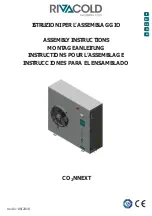
CO
2
NNEXT
rev.01
EN
71 / 293
2.2.4.
Notifications
The partly-completed machine is equipped, in addition to the luminous signals and the instruments installed
on the panel of the electrical panel, with indicator lights on the inside.
To access it, it may be necessary to remove one or more covering panels that close the structure.
For further information on the light signals and on the instruments of the electrical panel, refer to the wiring
diagram and to the relative documentation attached to this manual.
ATTENTION: Operations with the panel removed should only be performed by authorised/qualified
personnel.
Observe all foreseeable safety precautions and use the necessary PPE. At the
end of the intervention, always carefully replace all the panels removed.
Liquid passage light
It is a transparent indicator that is installed along the liquid line which allows understanding of the load state.
When the system is at full speed, the flow through the sight glass must be continuous and free from foams or
gas bubbles. If there is considerable turbulence with the presence of gas, wait a few minutes before
correcting the load; it could be a transitory phenomenon caused by rapid opening of a thermostatic valve.
Humidity reporting
On the liquid passage indicator it is possible to observe a coloured element that indicates if the refrigerant is
dry or contains moisture. Based on the colour, it is possible to understand the status.
In the presence of moisture it is possible to replace the dehydrating filter. Should the problem persist it is
necessary to stop the system, empty it and repeat the empty and load phases.
Oil level indicator light
It is installed on the oil separator (if present) and indicates the minimum level. Depending on the version of the
partly-completed machine there may be a second indicator to identify the maximum level. The oil level
check must be carried out when the system is fully operational for a few hours and for a few days after
starting.
If it is necessary to top up, always use only the type of oil indicated on the plate of the machine and/or in the
enclosed documentation.
Pressure reporting
The pressure reading at the different points of the circuit is possible by:
x
electronic control;
x
The installation of pressure gauges.
The pressure gauges must be connected to the service valves on the various points of the circuit. In case of
faired units, to access the connection points, it is necessary to remove the covering panels.
Indication of presence of malfunctions and presence of alarms
The presence of alarms is signalled by a red light directly on the electronic control terminal located on the
door of the partly-completed machine. The light can be flashing or fixed; in the first case, the light indicates
the presence of active and unseen alarms, the second identifies that the alarm has been viewed.
A red light on the electronic control display in the panel area generally indicates the malfunction and/or
alarms presence status. The specific cause can be identified by interrogation of the electronic control. These
signals can be acquired by a supervisory system.
Some alarms can be of manual reset type and therefore the intervention of a technician on the partly-
completed machine is required.
DANGER: Manual reset of the system or part of it following an anomaly involves the intervention of a
specialist technician who only after having analysed the causes and having resolved the problem
can restart the system.
DANGER: With R744 (CO2) refrigerant all operations must be carried out only by specialist
technicians trained to operate with this type of refrigerant.




























